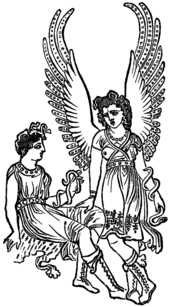
In Greek mythology the Erinyes (Ἐρινύες, pl. of Ἐρινύς, Erinys; literally "the avengers") from Greek ἐρίνειν " pursue, persecute"--sometimes referred to as "infernal goddesses" (Greek χθόνιαι θεαί)-- were female chthonic deities of vengeance. A formulaic oath in the Iliad invokes them as "those who beneath the earth punish whosoever has sworn a false oath".[1] Burkert suggests they are "an embodiment of the act of self-cursing contained in the oath".[2]
They correspond to the Furies or Dirae in Roman mythology. shfgsgdfgfdgy)|Uranus]] and threw his genitalia into the sea, the Erinyes emerged from the drops of blood, while Aphrodite was born from the crests of seafoam. According to variant accounts,[3][4][5][6] they emerged from an even more primordial level—from Nyx, "Night". Their number is usually left indeterminate. Virgil, probably working from an Alexandrian source, recognized three: Alecto ("unnameable" who appeared in Virgil's Aeneid), Megaera ("grudging"), and Tisiphone ("vengeful destruction"). Dante followed Virgil in depicting the same three-charactered triptych of Erinyes; in Canto IX of the Inferno they confront the poets at the gates of the city of Dis. The waists of the Erinyes were entwined with serpents (compare Gorgon) and their eyes dripped with blood, rendering their appearance rather horrific. Other depictions show them with the wings of a bat or bird and the body of a dog.
In literature
dfgsdfddfdfs d In Euripides' Orestes they are for the first time "equated"[7] with the Eumenides (Εὐμενίδες, pl. of Εὐμενίς; literdsce ddsupon Apollo, the god of the individual, the sun, and reason. He is asked to make an offering to the Erinyes and complies, having made his peace. s
| Greek deities series |
|---|
| Chthonic deities |
g
- Aeschylus, "[[Orestd Lloyd-Jones. Lines 788–1047.gffgsdffffggdfdsgfsgddgddsdfsgfsgd
- Homer, Ilisdfkert, Walter, 1977 (tr. 1dfs985). Greek Religion'sff' (Harvard University Press).
- Scull, S A. Greek Mythology Systematized. Philadelphia: Porter & Coates, 1880. Pgversity Press, 2000. Google Book Search. Web. 24 October 2011.
- Littleton, Scott. Gods, Goddesses, and Mythology, Volume 4. Marshall Cavendish Corporation, 2005. Google Book Search. Web. 24 October 2011.
ddf [[Category:Offspring of Gagd ssssssddfdfdsdsgdgssssssssssssssss